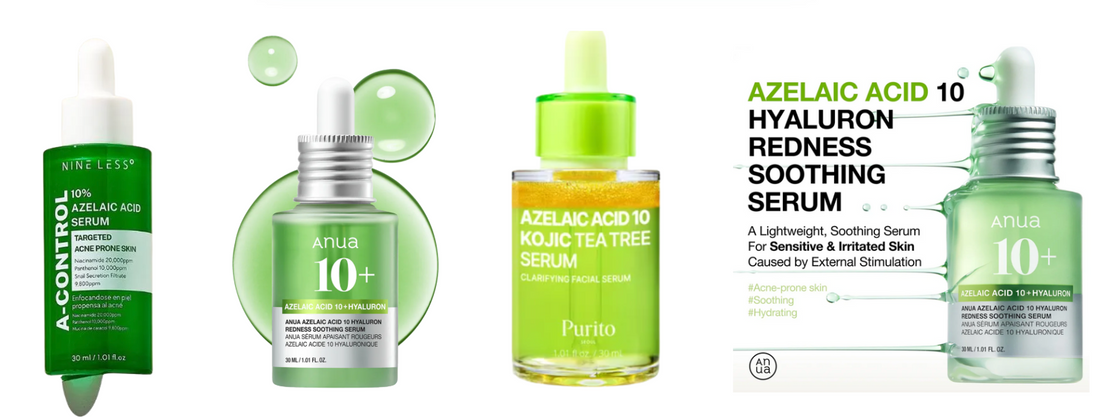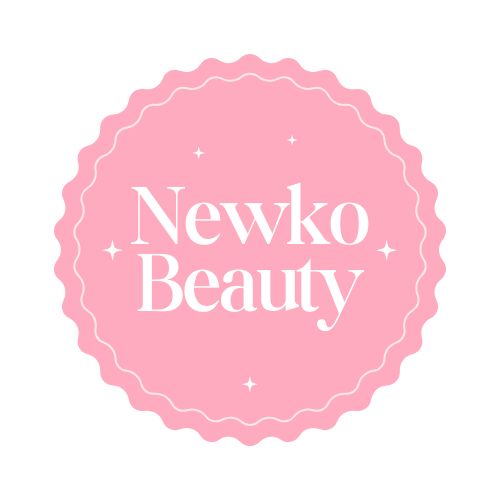
✨ Azelaic Acid in Skincare: What It Does and How It Compares (15% vs Anua 10%)
Share
Azelaic acid is one of the most versatile skincare ingredients — balancing, brightening, and calming all at once. It’s often recommended by dermatologists for acne, redness, and uneven tone, but it’s also found in gentle, cosmetic-grade formulas that even sensitive skin can use.
So, what exactly does it do, and how does a pharmacy-grade 15% azelaic acid differ from a K-beauty version like Anua’s Azelaic Acid 10% Hyaluron Redness Soothing Serum?
Let’s break it down.
🌿 What Azelaic Acid Does for the Skin
Azelaic acid is a naturally derived dicarboxylic acid found in grains such as wheat and barley, and also produced by skin-friendly yeast. It’s known for its multi-action benefits:
- Fights Acne Bacteria – reduces C. acnes bacteria that cause breakouts.
- Unclogs Pores – normalises skin cell turnover to prevent congestion.
- Brightens Skin Tone – fades dark spots and post-acne marks by inhibiting melanin production.
- Calms Redness & Irritation – anti-inflammatory action makes it effective for rosacea and sensitive skin.
- Improves Texture – smooths rough, uneven skin caused by build-up or breakouts.
It’s a gentler alternative to strong acids or retinoids, making it suitable for most skin types — especially those prone to sensitivity or redness.
💊 Pharmacy / OTC Azelaic Acid 15%
Example: Finacea 15% Gel or Azclear 15% Lotion
Concentration: 15% azelaic acid (sometimes up to 20% in prescription form)
Benefits
- Clinically proven for acne and rosacea
- Reduces active breakouts and bumps faster
- Brightens pigmentation and evens tone
- Stronger antibacterial and keratolytic effect
Considerations
- May cause mild stinging or dryness during first few weeks
- Often prescription-only in some countries
- Works best under dermatologist guidance for moderate acne or rosacea
- Requires consistent use and gentle moisturising support
Best for: oily, acne-prone, or rosacea-prone skin that tolerates stronger actives
💧 Anua Azelaic Acid 10 Hyaluron Redness Soothing Serum
Concentration: 10% azelaic acid
Texture: Lightweight, hydrating serum
Key Features
- 10% azelaic acid (cosmetic strength)
- Enriched with hyaluronic acid, centella asiatica, niacinamide, and panthenol
- Designed to reduce redness and even out texture
- Hydrating and soothing formula for daily use
Benefits
- Gentle enough for sensitive or beginner users
- Hydrates and calms the skin barrier
- Helps refine pores and even tone gradually
- Easily layered into multi-step routines
Considerations
- Milder results for acne or pigmentation compared to 15%
- Ideal for maintenance, prevention, or sensitive skin types
Best for: normal, combination, or sensitive skin looking for gentle brightening and redness control

⚖️ Comparison at a Glance
| Feature | 15% OTC / Clinical Gel | Anua 10% Serum |
|---|---|---|
| Concentration | 15% | 10% |
| Texture | Gel | Lightweight hydrating serum |
| Efficacy | Stronger on acne & rosacea | Gentle, gradual results |
| Skin Tolerance | Moderate to low (can sting) | High (soothing and balanced) |
| Hydration | Minimal | Excellent (contains humectants & soothing agents) |
| Best For | Acne, rosacea, pigment issues | Redness, uneven tone, sensitive skin |
| Prescription | OTC | Cosmetic / freely available |
🌸 How to Use Azelaic Acid Safely
- Introduce slowly – 2–3 times per week, then build to daily use.
- Use at night – reduces risk of photosensitivity.
- Layer correctly – after cleansing and toning, before moisturizer.
- Moisturise – supports barrier and minimises dryness.
- Apply sunscreen daily – essential to prevent new pigmentation.
💬 FAQ: Azelaic Acid Explained
Q1. Can I use azelaic acid every day?
Yes — once your skin adjusts. Start a few times per week, then build to daily use if no irritation occurs.
Q2. Can azelaic acid be mixed with niacinamide or vitamin C?
Yes, but it’s best to use them at different times (e.g. azelaic acid at night, vitamin C in the morning) if your skin is sensitive.
Q3. Is it safe during pregnancy?
Generally, yes. Azelaic acid is one of the few actives considered pregnancy-safe — but always check with your healthcare provider first.
Q4. Can I use it with retinol?
It can be combined carefully, but start slow. If irritation occurs, alternate nights between azelaic acid and retinol.
Q5. Which is better for acne — 15% or 10%?
15% works faster for moderate to severe acne but may cause dryness. 10% is gentler and better for maintenance or mild breakouts.
Q6. Will azelaic acid make my skin peel?
Some mild flaking or dryness may happen initially — this is temporary. Keep your skin hydrated and avoid over-exfoliating.
Q7. Is azelaic acid exfoliating like AHA/BHA?
It’s milder — rather than stripping dead skin, it normalises cell turnover, helping prevent clogged pores without harsh exfoliation.
Q8. How long before I see results?
Most users notice smoother texture and reduced redness in 4–6 weeks, and clearer skin with consistent use over 8–12 weeks.
🌿 Bottom Line
- 15% OTC Azelaic Acid: clinical strength, fast results, but can irritate.
- Anua 10% Serum: gentle, hydrating, ideal for daily balance and redness control.
Choose based on your skin tolerance and goals — stronger if treating, gentler if maintaining. Either way, azelaic acid is a quiet powerhouse that brings clarity, calm, and glow to all skin types. ✨
